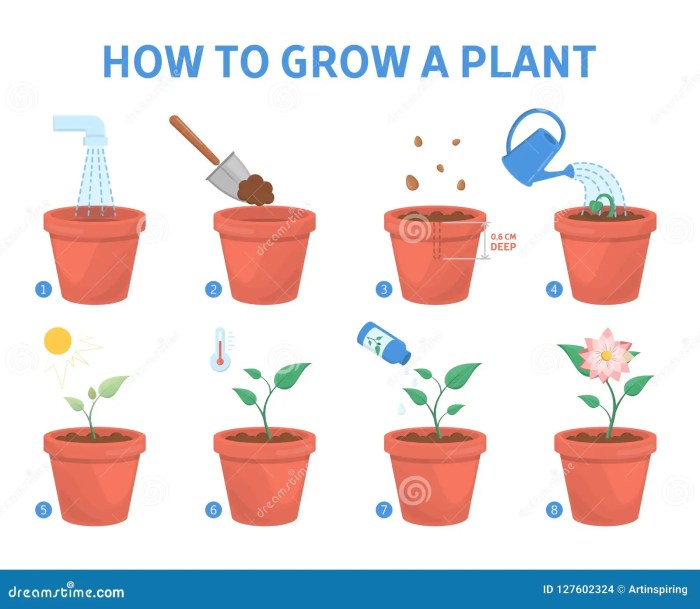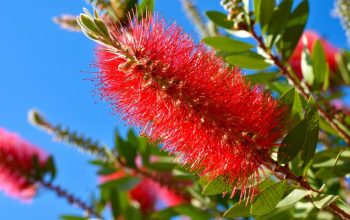Planting and Initial Care: How Do You Grow A Pot Plant

How do you grow a pot plant – Planting your new pot plant is like giving it a little slice of Bali paradise – a chance to thrive! Get it right from the start, and you’ll be rewarded with lush, healthy growth. Think of it as setting up your plant’s new villa.Planting a Seedling or Established PlantPlanting your new plant is super chill. For a seedling, gently remove it from its nursery pot, being careful not to damage the delicate roots.
For an established plant, loosen the root ball slightly to encourage outward growth. Choose a pot slightly larger than the root ball, with drainage holes to prevent soggy roots – nobody likes a flooded villa! Place a layer of potting mix at the bottom, then position the plant, ensuring the top of the root ball is level with the rim of the pot.
Fill the remaining space with potting mix, gently firming it around the base. Water thoroughly after planting.
Watering Newly Planted Pot Plants
Watering is key, but don’t drown your little plant friend! Water deeply enough to saturate the soil, allowing excess water to drain from the drainage holes. The frequency depends on factors like the type of plant, pot size, and environmental conditions. A good rule of thumb is to check the soil moisture – if the top inch feels dry, it’s time to water.
Avoid letting the soil completely dry out, especially for newly planted plants. Overwatering can lead to root rot, while underwatering will cause wilting. Observe your plant – it will tell you what it needs! For example, a cactus will need less frequent watering than a fern.
Optimizing Light Exposure
Bali’s sunshine is amazing, but too much direct sun can scorch your plant’s leaves. Most tropical plants love bright, indirect light. Position your pot near a window that gets plenty of sunlight, but avoid placing it in direct sunlight, especially during the hottest part of the day. Observe your plant’s leaves; if they start to yellow or brown, it might be getting too much sun.
If they’re stretching towards the light, it might need more sun. Experiment with different locations until you find the perfect spot – it’s all about finding that sweet spot. Think of it as finding the perfect sun lounger on the beach!
Common Initial Planting Problems and Solutions, How do you grow a pot plant
Sometimes things don’t go exactly to plan. Common problems include wilting, yellowing leaves, and pest infestations. Wilting can be caused by underwatering or root shock. Yellowing leaves can indicate overwatering, underwatering, or nutrient deficiency. Pest infestations can be tackled with natural remedies like neem oil or insecticidal soap.
So, you wanna grow some bomb pot plants? First things first, get the right soil mix and a sunny spot. Then, choose the perfect pot – check out these awesome options for pot plant pots outdoor to find something stylish and practical. After that, it’s all about watering and making sure your plants get enough sunlight to thrive.
Easy peasy, right?
Don’t panic! Observe your plant carefully, identify the problem, and take corrective action. Remember, a little patience and attention go a long way in creating a thriving little Bali garden in your home.
Ongoing Care and Maintenance

Maintaining your thriving pot plant in Bali’s vibrant climate is all about finding the right balance – a little bit of this, a little bit of that, and a whole lotta love! Think of it like tending to a good friend; consistent care ensures a long and beautiful relationship. We’re talking regular feeding, mindful watering, and a keen eye for any potential problems.Regular Fertilization and Fertilizer RecommendationsProviding your plant with the right nutrients is key to its health and growth.
Think of fertilizer as a delicious Balinese meal for your plant – it provides the essential vitamins and minerals needed to flourish. Different plants have different needs, so choosing the right fertilizer is crucial. For most tropical plants, a balanced liquid fertilizer, with an NPK ratio (Nitrogen, Phosphorus, Potassium) of around 10-10-10, diluted according to the product instructions, works well.
Organic options like compost tea are also excellent choices, offering a slow-release of nutrients and improving soil structure. Avoid over-fertilizing, as this can burn the roots and harm your plant. A good rule of thumb is to fertilize every 2-4 weeks during the growing season (typically spring and summer).Watering, Fertilizing, and Pruning ScheduleA consistent schedule is your best friend when it comes to plant care.
The frequency of watering, fertilizing, and pruning will depend heavily on the specific plant, the season, and the environment. For example, a succulent will need far less frequent watering than a fern. During the hotter, drier months, you’ll likely need to water more often, while in the rainy season, you may need to water less, and even skip fertilizing altogether.
A good rule of thumb is to check the soil moisture before watering – if the top inch feels dry, it’s time to water. Pruning should be done as needed to remove dead or damaged leaves and encourage bushier growth. Always use sharp, clean pruning shears to prevent disease.Overwatering and Underwaterings and Their SolutionsOverwatering is a common problem, especially for beginners.
Signs of overwatering include yellowing leaves, soggy soil, and a foul odor coming from the pot. If you suspect overwatering, immediately reduce watering frequency and allow the soil to dry out completely between waterings. You might even need to repot your plant in fresh, well-draining soil. Underwatering, on the other hand, manifests as wilting leaves, dry soil, and stunted growth.
If your plant is underwatered, water thoroughly until water drains from the drainage holes, ensuring the soil is evenly moist.Common Pests and Diseases and Their Prevention and TreatmentJust like humans, plants can suffer from pests and diseases. Common pests include aphids, mealybugs, and spider mites. These tiny critters can suck the life out of your plant, leaving it weak and vulnerable.
Regular inspection is key to early detection. Treatment options include insecticidal soap, neem oil, or even a strong spray of water. Diseases, such as root rot (often caused by overwatering), can be more challenging to treat. Prevention is always best – using well-draining soil, ensuring good air circulation, and avoiding overwatering are crucial steps. If a disease takes hold, removing affected parts and applying a suitable fungicide might be necessary.
Always remember to identify the specific pest or disease before applying any treatment.
Detailed FAQs
What are the signs of root rot?
Root rot manifests as wilting, yellowing leaves, and a foul odor emanating from the soil. The roots themselves will be mushy and brown.
How often should I water my pot plant?
Watering frequency depends on the plant, pot size, and environmental conditions. Check the soil moisture before watering; water thoroughly when the top inch of soil feels dry.
What type of fertilizer is best for pot plants?
A balanced liquid fertilizer diluted to half strength is generally suitable. Follow the product instructions for application rates.
How do I prevent pests and diseases?
Regularly inspect your plants for pests and diseases. Maintain good air circulation, avoid overwatering, and use appropriate preventative treatments as needed.












